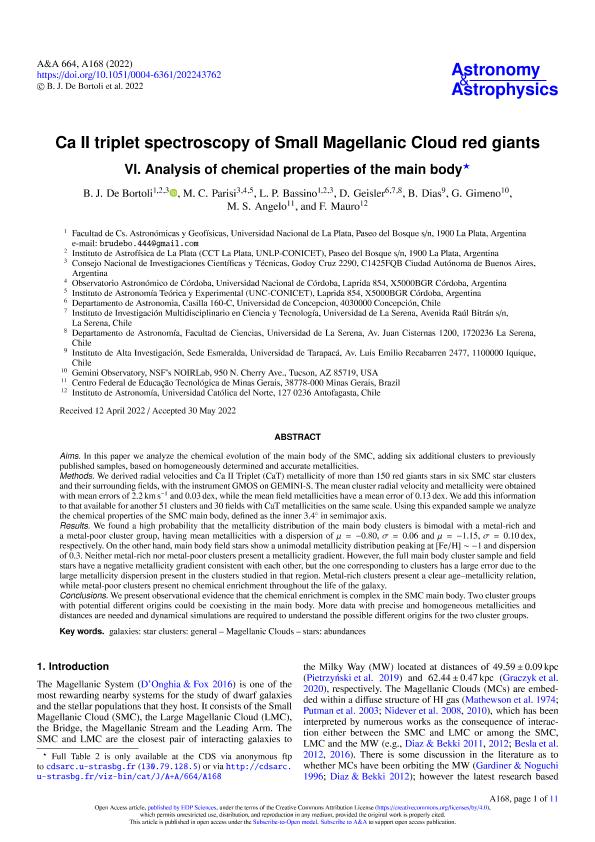Artículo
Ca II triplet spectroscopy of Small Magellanic Cloud red giants VI: Analysis of chemical properties of the main body
de Bórtoli, Bruno Javier ; Parisi, Maria Celeste
; Parisi, Maria Celeste ; Bassino, Lilia Patricia
; Bassino, Lilia Patricia ; Geisler, Doug; Dias, Bruno; Gimeno, G.; Dangelo Farto, Marcela Silvina; Mauro, F.
; Geisler, Doug; Dias, Bruno; Gimeno, G.; Dangelo Farto, Marcela Silvina; Mauro, F.
 ; Parisi, Maria Celeste
; Parisi, Maria Celeste ; Bassino, Lilia Patricia
; Bassino, Lilia Patricia ; Geisler, Doug; Dias, Bruno; Gimeno, G.; Dangelo Farto, Marcela Silvina; Mauro, F.
; Geisler, Doug; Dias, Bruno; Gimeno, G.; Dangelo Farto, Marcela Silvina; Mauro, F.
Fecha de publicación:
08/2022
Editorial:
EDP Sciences
Revista:
Astronomy and Astrophysics
ISSN:
0004-6361
Idioma:
Inglés
Tipo de recurso:
Artículo publicado
Clasificación temática:
Resumen
Aims. In this paper we analyze the chemical evolution of the main body of the SMC, adding six additional clusters to previously published samples, based on homogeneously determined and accurate metallicities. Methods. We derived radial velocities and Ca II Triplet (CaT) metallicity of more than 150 red giants stars in six SMC star clusters and their surrounding fields, with the instrument GMOS on GEMINI-S. The mean cluster radial velocity and metallicity were obtained with mean errors of 2.2 km s-1 and 0.03 dex, while the mean field metallicities have a mean error of 0.13 dex. We add this information to that available for another 51 clusters and 30 fields with CaT metallicities on the same scale. Using this expanded sample we analyze the chemical properties of the SMC main body, defined as the inner 3.4◦ in semimajor axis. Results. We found a high probability that the metallicity distribution of the main body clusters is bimodal with a metal-rich and a metal-poor cluster group, having mean metallicities with a dispersion of µ = -0.80, σ = 0.06 and µ = -1.15, σ = 0.10 dex, respectively. On the other hand, main body field stars show a unimodal metallicity distribution peaking at [Fe/H] ∼ -1 and dispersion of 0.3. Neither metal-rich nor metal-poor clusters present a metallicity gradient. However, the full main body cluster sample and field stars have a negative metallicity gradient consistent with each other, but the one corresponding to clusters has a large error due to the large metallicity dispersion present in the clusters studied in that region. Metal-rich clusters present a clear age–metallicity relation, while metal-poor clusters present no chemical enrichment throughout the life of the galaxy. Conclusions. We present observational evidence that the chemical enrichment is complex in the SMC main body. Two cluster groups with potential different origins could be coexisting in the main body. More data with precise and homogeneous metallicities and distances are needed and dynamical simulations are required to understand the possible different origins for the two cluster groups.
Palabras clave:
GALAXIES: STAR CLUSTERS: GENERAL
,
MAGELLANIC CLOUDS
,
STARS: ABUNDANCES
Archivos asociados
Licencia
Identificadores
Colecciones
Articulos(IALP)
Articulos de INST.DE ASTROFISICA LA PLATA
Articulos de INST.DE ASTROFISICA LA PLATA
Articulos(IATE)
Articulos de INST.DE ASTRONOMIA TEORICA Y EXPERIMENTAL
Articulos de INST.DE ASTRONOMIA TEORICA Y EXPERIMENTAL
Citación
de Bórtoli, Bruno Javier; Parisi, Maria Celeste; Bassino, Lilia Patricia; Geisler, Doug; Dias, Bruno; et al.; Ca II triplet spectroscopy of Small Magellanic Cloud red giants VI: Analysis of chemical properties of the main body; EDP Sciences; Astronomy and Astrophysics; 664; 8-2022; 168-179
Compartir
Altmétricas



